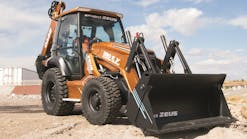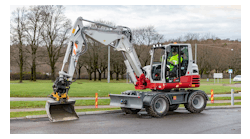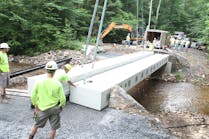A couple of weeks back, a friend who maintains an ambitious program of forwarding emails about subjects she considers important (in this case, life after 50) sent an email with the subject line “Reaction Test.” It turned out to be an exercise in predicting your age based on your reaction time. You’re in the driver’s seat of a car heading down a two-lane highway. Trees appear and a few deer munch grass on either side of the road when suddenly a red hand appears telling you to stop. You apply the brakes, pounding a random key on the keyboard.
I couldn’t resist. I took the test once, then twice more, and was informed that my reaction was typical, first of someone aged 41, then 30, then 20—I was getting younger by the minute. I laughed and deleted the email, but the experience reminded me that I had been wanting to update the use of simulator-based training in the construction industry.
I first looked at heavy equipment simulators about eight years ago when I reported that the idea of using computers to train operators was making inroads “propelled by the need for skilled operators and increased productivity, high operating costs, and looming safety regulations.”
It made sense. Simulators give operators—either greenhorns just starting out or seasoned old hands trying out new equipment—the opportunity to practice maneuvers in a controlled, safe environment. Simulators are efficient—multiple operators can be trained simultaneously and on different types of machines. Simulators are more cost-effective than training on actual machines because they save on maintenance and operating costs and free up equipment for the job site.
Back then, the major manufacturers—Caterpillar, John Deere, Volvo—were developing and marketing simulators and only too happy to talk about their benefits. At Pennsylvania College of Technology in Williamsport, PA, diesel and heavy equipment instructor Budd Greevy maintained that putting students in a simulator before they take a seat on a live machine makes them feel more comfortable and self-confident, which in turn gets them digging efficiently a lot faster. The then-executive director of the Operating Engineers (OE) Training Institute of Ontario, which uses Vortex simulators from Montreal-based CM Labs Simulations, estimated that simulators are an efficient way to accumulate the 180–200 hours of seat time that it takes for an apprentice to operate a machine safely and efficiently.
Overall, the logic seemed to be to give operators enough time in a simulator and they’ll be ready to handle the real thing.
Way back then, CM Labs COO Arnold Free described the best simulator experience as going beyond the basics of controls to how to use the machine in typical work environments, even going so far as to suggest that simulator scenarios be customized to focus on the type of work individual companies specialize in. Larry Estep, then Caterpillar’s manager for simulators, had a practical explanation for why simulator-assisted training was beginning to make its mark. “Contractors are realizing that productivity boils down to the quality of the operator. We can spend all kinds of R&D money to design the best machines in the world, and our customers can spend lots of money to buy them, but as soon as you put an operator in the seat, everything can change if he doesn’t know what he’s doing.”
Greevy was a particular fan of the performance evaluation feedback that simulators offer. “When a student is working on the controls of a live machine, they’re effectively evaluating themselves. With the simulator, real numbers pop up, and when they see what they’re getting is one-third buckets or half buckets, they recognize they have to keep working at it. On a live excavator, students basically dig air until they get the feel of the controls, burning fuel. The simulator takes pennies an hour to run, and the instructor is right there beside them.” At CM Labs, Free saw this “post-mission review” as one of the most important aspects of heavy equipment training.
The anecdotal information seemed to be supported by theory. According to the experts, we learn via an interrelated three-part system of cognitive, affective, and psychomotor learning. Cognitive learning refers to the straightforward acquisition of knowledge, followed by comprehension (I get it), application (I can use it), and the more high level skills of analysis and evaluation (I’ll do it because I have to in order to accomplish x, y, or z). Affective learning is a function of individual interests, attitudes, values, and emotional biases, which affect the degree to which we become aware of, or sensitive to, ideas or information and feel OK to follow, commend, or recommend them to others. Psychomotor learning refers to movement and/or physical activities where muscles “express” or “interpret” the learned information or concepts. It seemed logical that this was where simulators could shine.
Annette Kiesewetter, marketing director for CAT simulators, suggests that the use of simulators in the construction industry has expanded in part because of a blurring of the lines between the different types of learning. “There’s a whole new generation out there that wants to learn with technology. The generation coming up not only craves technology; they expect it.” 10 years ago, the bulk of dedicated heavy equipment simulators (as opposed to desktop models marketed by Simlog) were sold to unions and tech schools and a few early adopters among larger construction companies that could afford the price tag. And even with that, it was often a hard sell. Not so anymore, says Kiesewetter.
“We don’t have to justify simulation anymore. I can’t even remember the last time I heard that conversation. Now our customers want to talk about reporting functions and tracking user progress.”
At Volvo, Wade Turlington, director, Customer Center, Product Sales, and Operator Training, Road Institute, says the market hasn’t changed much among construction firms. “Simulators are still very expensive and smaller construction companies usually don’t have the internal resources [i.e., training departments] to capture the ROI.” But the larger companies are being creative. Turlington just sold two simulators to a large multi-state construction company that plans to use them for developing laborers into operators and new-hire screenings as well as having them at expos, job fairs, and recruiting events.
Kiesewetter agrees that small- and medium-sized companies haven’t taken on simulator-based training but instead are going though colleges and technical schools. “And the colleges are responding because it’s a great opportunity, whether it’s kids coming out of high school or someone making a mid-career change. We’ve teamed up with OE 324 in Michigan in its apprenticeship program. They call the program the other four-year degree because they’re training kids out of high school, basically educating them for free, and they go to work immediately. The simulators are helping develop the workforce they need for all the projects going on in Michigan.”
Turlington has noticed a similar trend, particularly in the past 16–24 months, wherein there is increased interest in using equipment simulators not only at vocational-tech and community colleges but also at the high school level to help close the skills gap. “Simulators, especially full motion simulators, are often seen as video games. For this reason, we are focusing heavily on the student learning experience and development path. We recently launched Volvo’s Operator Performance System (OPS), a new Learning Management System and new exercises for our simulators. The exercises have built-in operator development material and are bundled with relevant videos to make it easier for students to understand how to complete an assigned task. OPS also provides instant feedback so students see what they’ve done well and areas where they need improvement. Feedback is based on targets for fuel efficiency, production, wear and tear, and safety, with each one weighing in to the total score of an exercise. OPS also allows students to compare their results with other students in their group. We believe that all operators want to be good operators. Being able to compare performance with others helps motivate them to improve.”
“This is not to mention that the simulators themselves have changed. You’d be amazed if you sat down in front of one of them today,” says Kiesewetter. “You’re looking at three large screens and graphics that are so good it’s like you’re looking out the window. All the controls are exactly as you would see them on the work site in the actual machine that you will be working on. We develop the exercises based on input from CAT on the way job sites are run around the world. So you’re teaching consistency. An operator can work on a job site in the US or get on a plane and fly to Australia and work on a job site over there using the very same methodology. That’s worth a lot.
“The unions will tell you that the construction field is becoming very technologically advanced. OE 324 is running drone classes, for example, and they’re training on GPS. At CAT we’re getting ready to release virtual reality on our construction excavator. With the headset on, you’re much more immersed in the environment. You have better depth perception and it keeps the distractions of the outside world out.”
One thing that hasn’t changed is the cost—roughly $60,000–100,000 for the type of simulators Turlington and Kiesewetter describe. But Kiesewetter takes the position that affordability is in the eye of the beholder. “You can buy a half-million dollar machine and hope a novice operator doesn’t crash it, or you can buy a $70,000 simulator and make sure that if they crash it, it’s in the virtual world. And it’s so much safer for the instructors. One of the union instructors described how in the old days, they were either on the ground yelling through the windows or trying to hang on to the outside of the machine. Which cracked me up—the old days were yesterday.”









